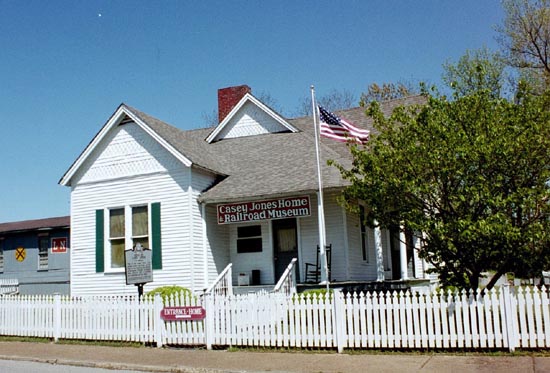
JACKSON, Tenn. — When Casey Jones’ locomotive crashed near Vaughn, Miss., he vaulted into history and American folklore.
The subject of songs and books, Jones, who died on April 30, 1900, has become a larger than life figure in American history in the 11 decades since his death.
But, finding the real Casey Jones is as simple as driving to Jackson, Tenn., where visitors can see the humble home where Jones lived at the time of his death.
Born John Luther Jones on March 14, 1863, in Southeast Missouri, he grew up in Cayce, Ky., the town that provided him with his nickname. When he was 15-years-old, Jones became an apprentice telegraph operator on the Mobile & Ohio Railroad, and in March 1888, he took a job with the Illinois Central Railroad, pulling mostly freight trains for his first 11 years.
In 1899, Jones was offered a position as an engineer on the railroad’s Cannonball passenger train, connecting Chicago and New Orleans. He accepted the position and started engineering on the run in February 1900. In the early morning hours of April 30, 1900, Jones, filling in for a sick engineer, sat behind the throttle of engine No. 382, pulling train No. 1, also known as the New Orleans Special.
Jones’ train pulled out of the Memphis train station at 12:50 a.m., about 90 minutes behind schedule. By the time Jones reached Durant, Miss., he had made up almost all of the train’s lost time.
Jones’ train was traveling as fast as 75 mph when it approached a stopped train at a siding near Vaughn, Miss. Jones’ locomotive hit a torpedo – a warning flare placed on the track to alert the engineer of the situation ahead. But, it was too late. Jones told his fireman, Sim Webb, to jump from the train, saving his life. Jones threw the train in reverse, hoping to stop before a collision.
Though his train crashed, Jones saved the lives of countless passengers.
Today, his house is a museum. Although it has been moved from its original location, it is open to the public and features a wide array of exhibits, including railroad memorabilia and Jones’ personal effects.
A life-sized replica of Illinois Central engine No. 382 – the locomotive Jones was engineering on his last trip – sits behind Jones’ house. The actual locomotive was repaired after the wreck and ran for 35 years before being scrapped.
The museum’s replica formerly ran on the Clinchfield Railroad as engine No. 99. The locomotive was restored and moved to the museum.
Beyond Jones, Jackson’s railroad past is deep and rich. Railroads came to Jackson in the latter half of the 1850s, and within a few years of their arrival, the city would become a regional railroad hub. Judge Milton Brown is often attributed with helping draw the railroad to Madison County and Jackson.
During its heyday, several railroads served Jackson, including the Nashville, Chattanooga and St. Louis, Illinois Central and the Gulf, Mobile and Ohio railroads. Today three railroads – Norfolk Southern, CSX and the West Tennessee Railroad – still serve the western Tennessee city of Jackson.
Federal troops, acknowledging the Jackson’s importance as a railroad hub, occupied the city for much of the Civil War. A train depot serves as a reminder of the city’s railroading past. Built in 1907, the Nashville, Chattanooga and St. Louis Railroad depot was restored in the 1990s and is today a museum dedicated to the city’s rail history.
Gracing the museum’s grounds include three rail cars – a pair of cabooses and an Amtrak dining car. Inside the depot is a model railroad exhibit, built and maintained by the Jackson Model Railroad Club. The depot also houses a vast collection of railroad-related relics with photographs and artifacts.



